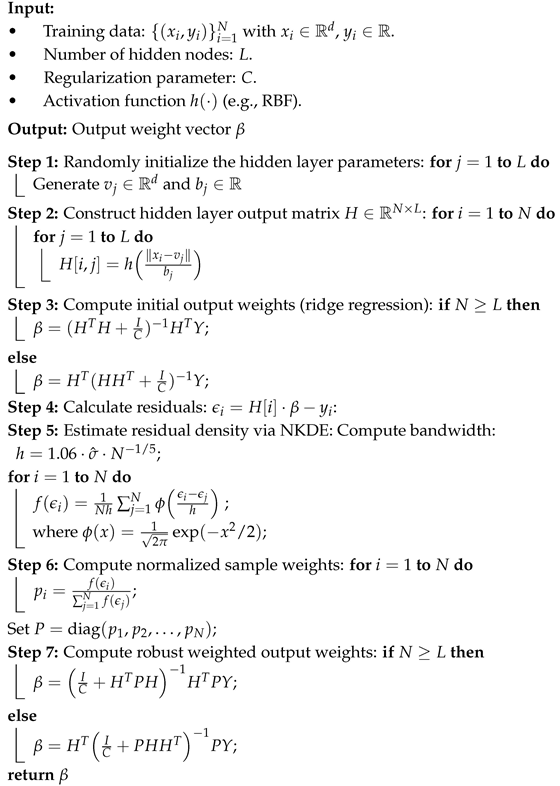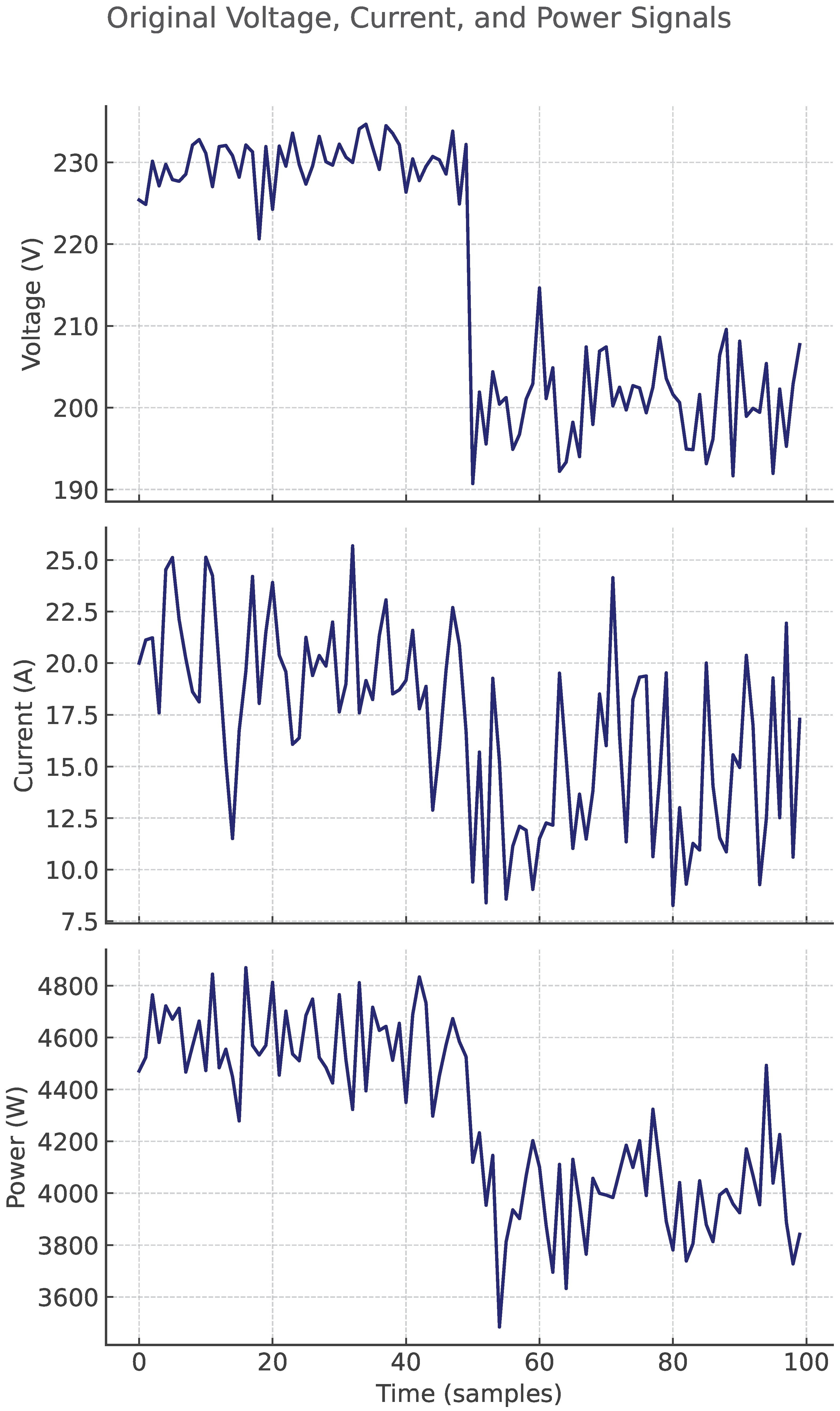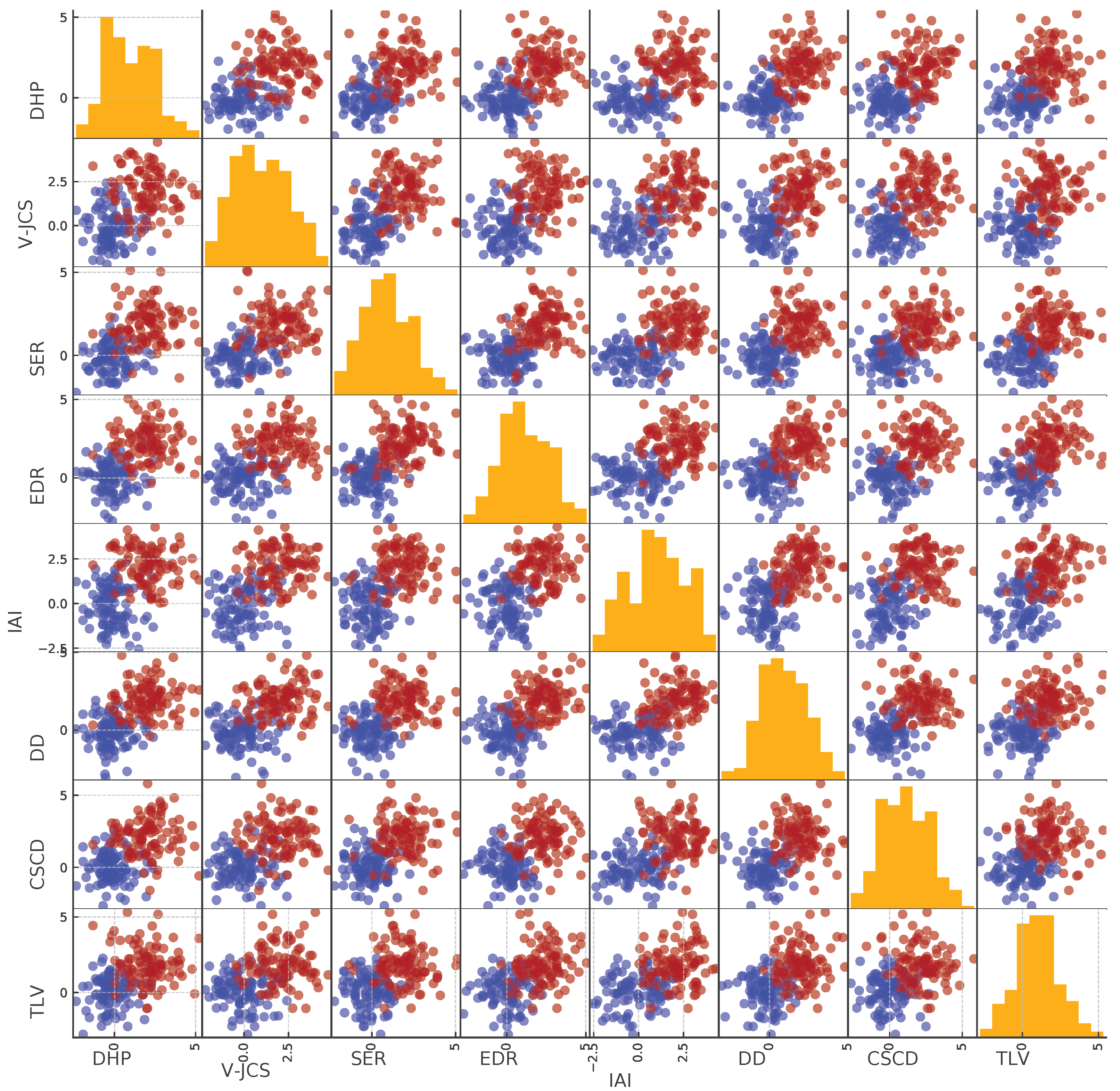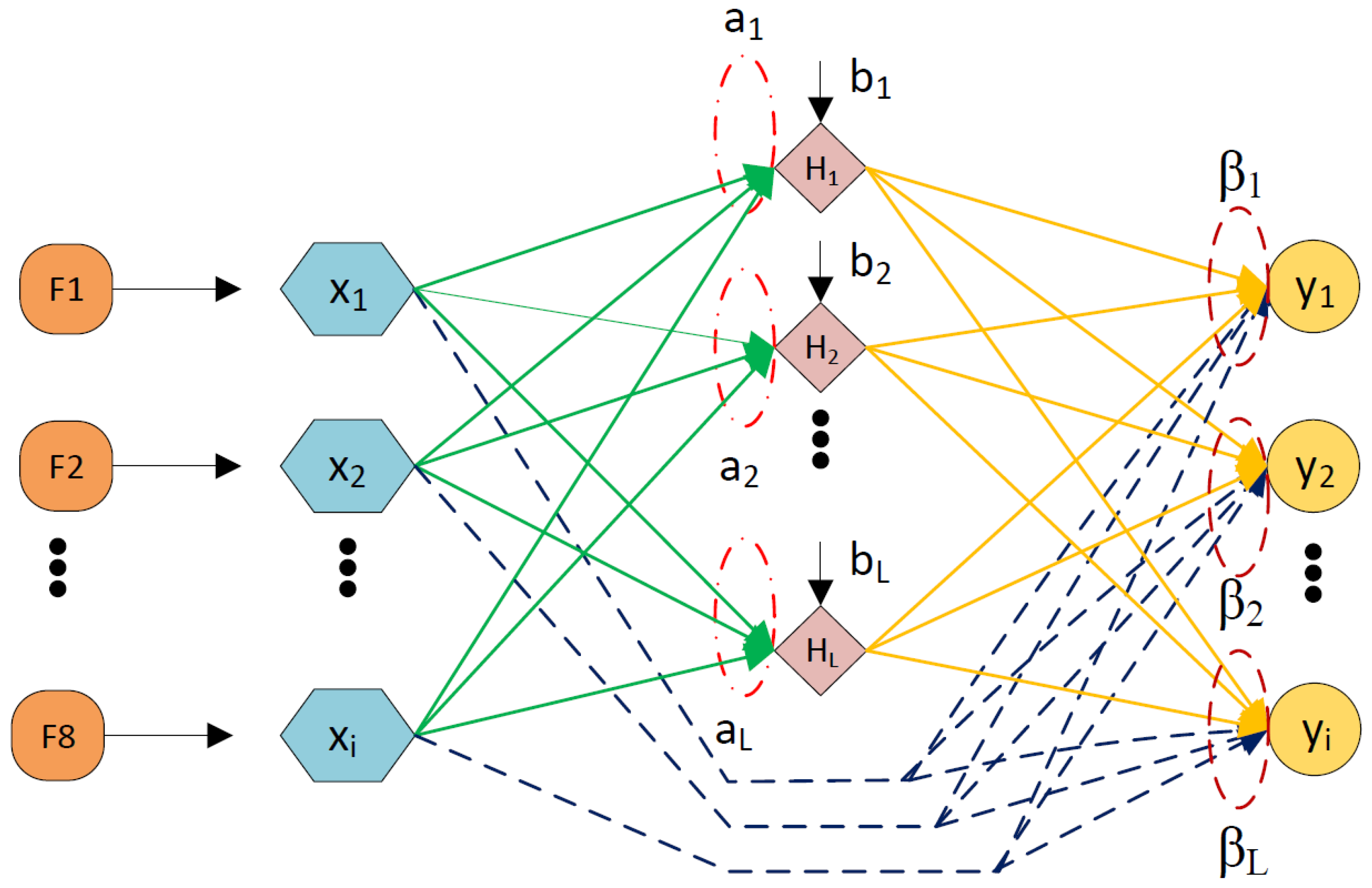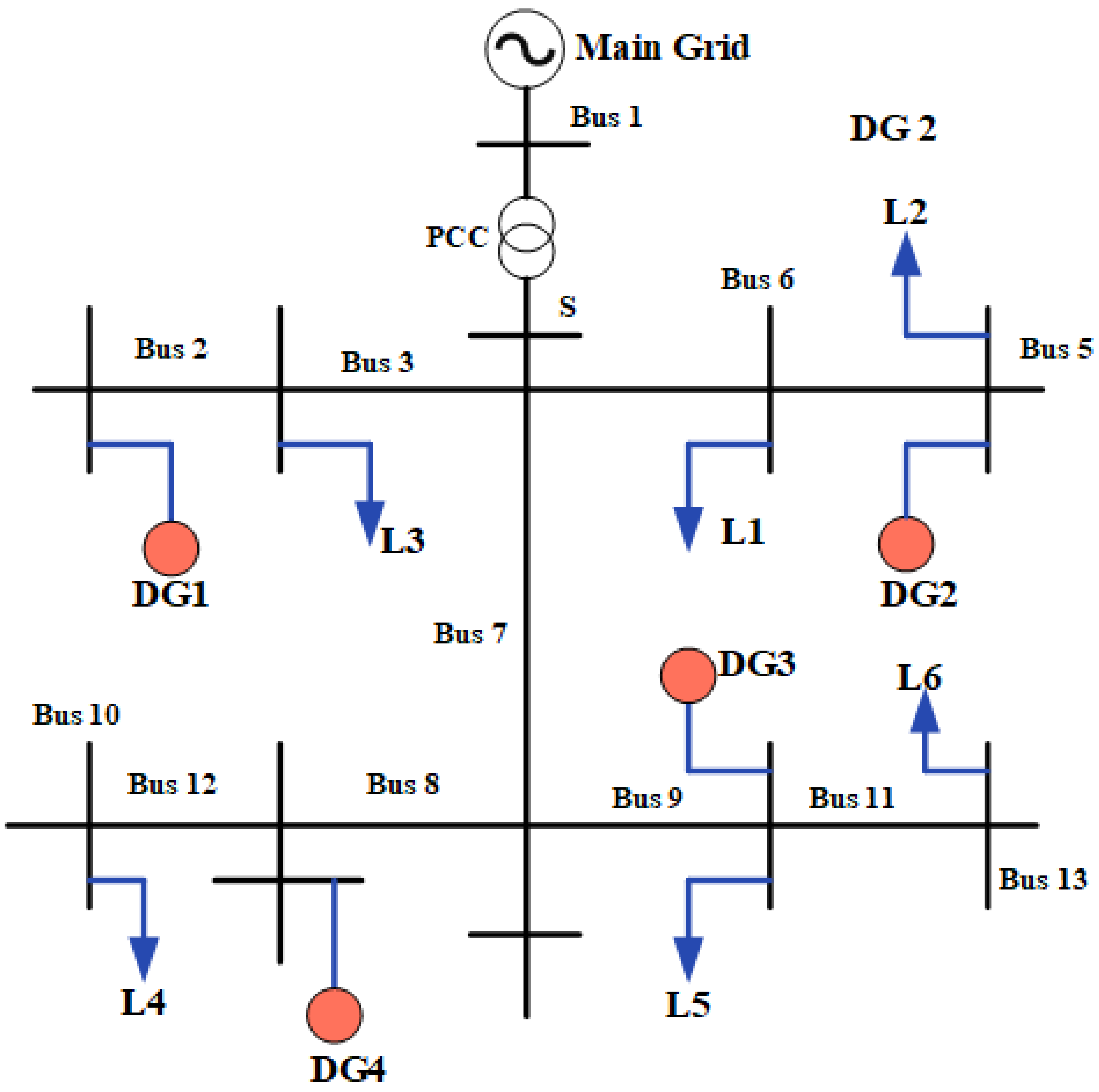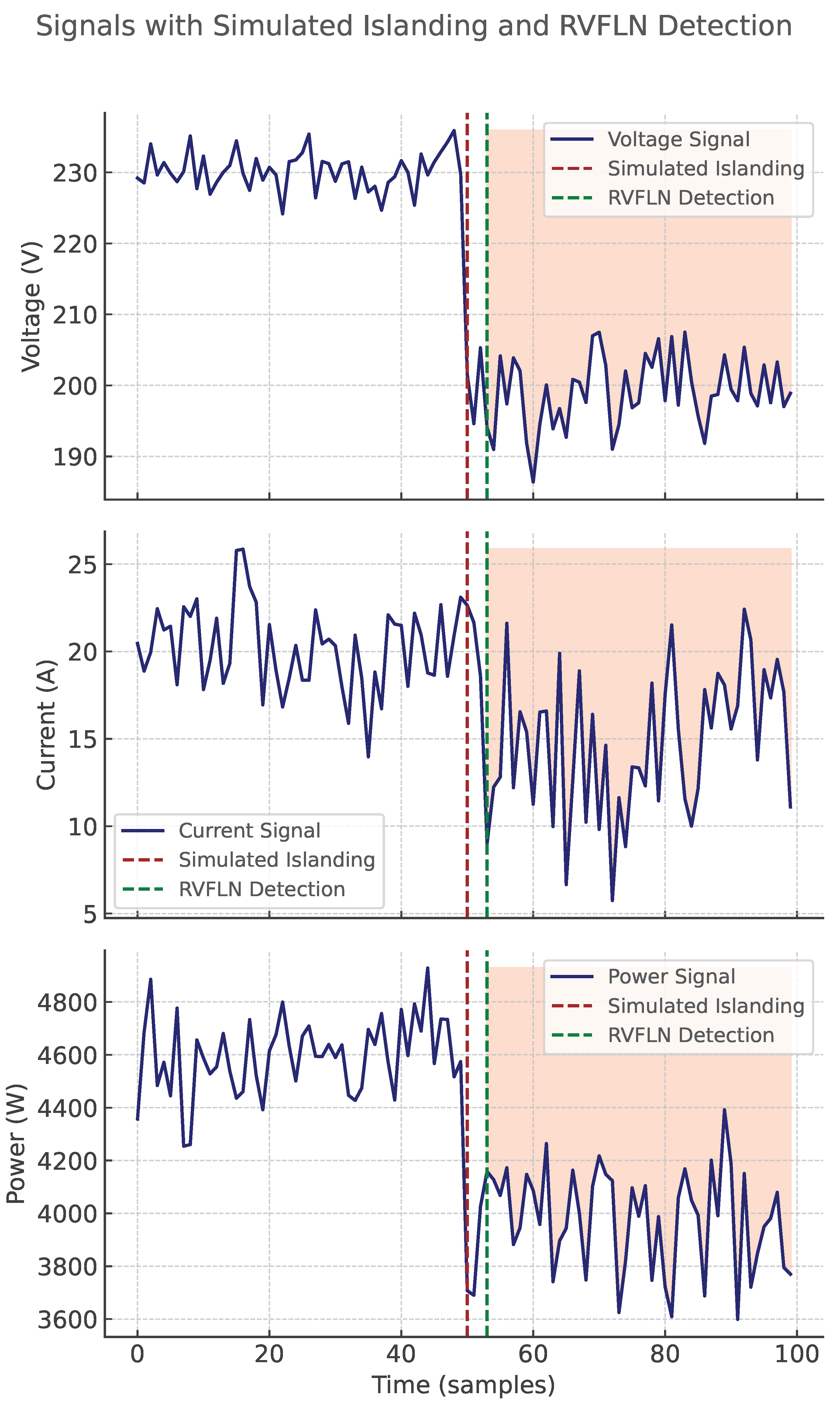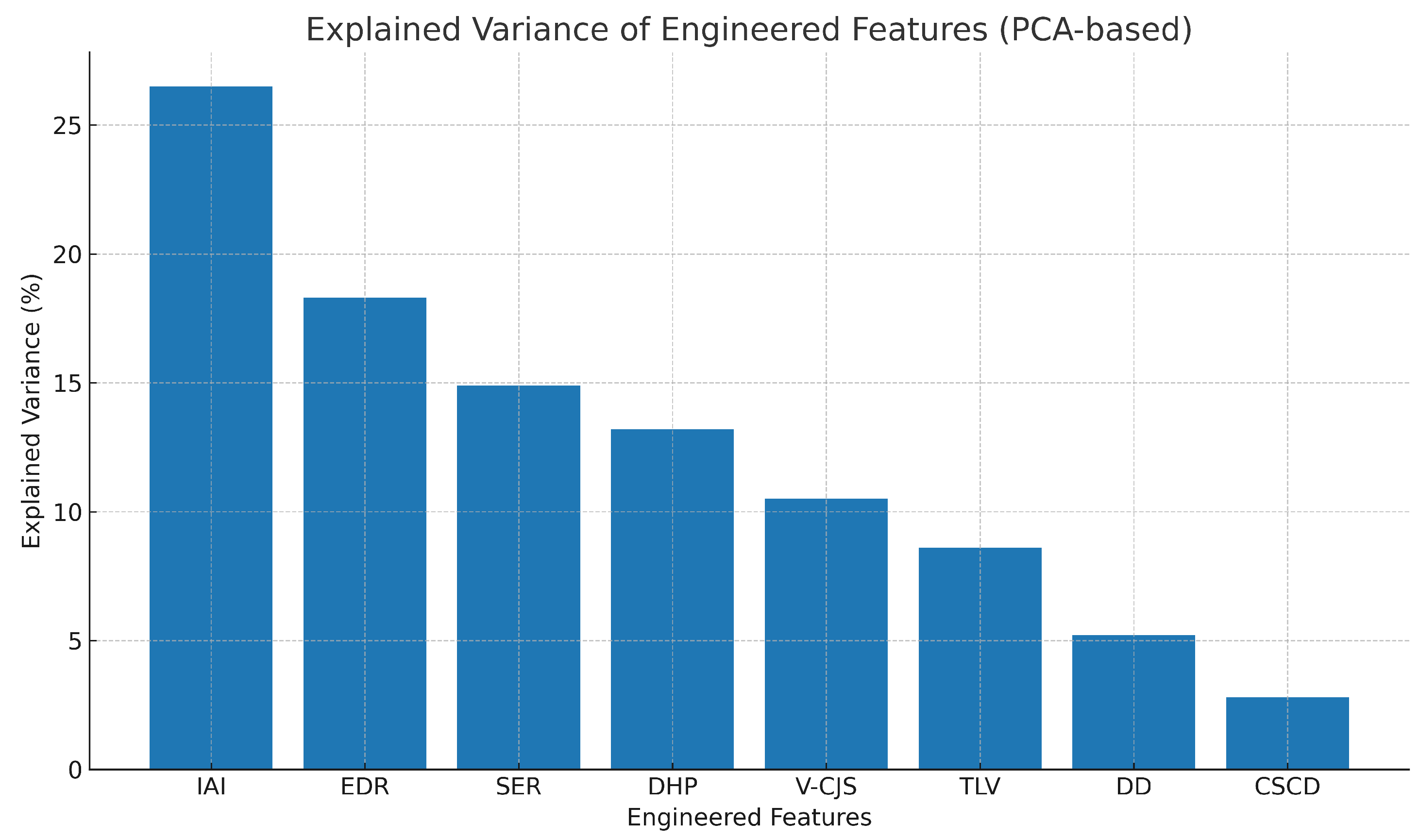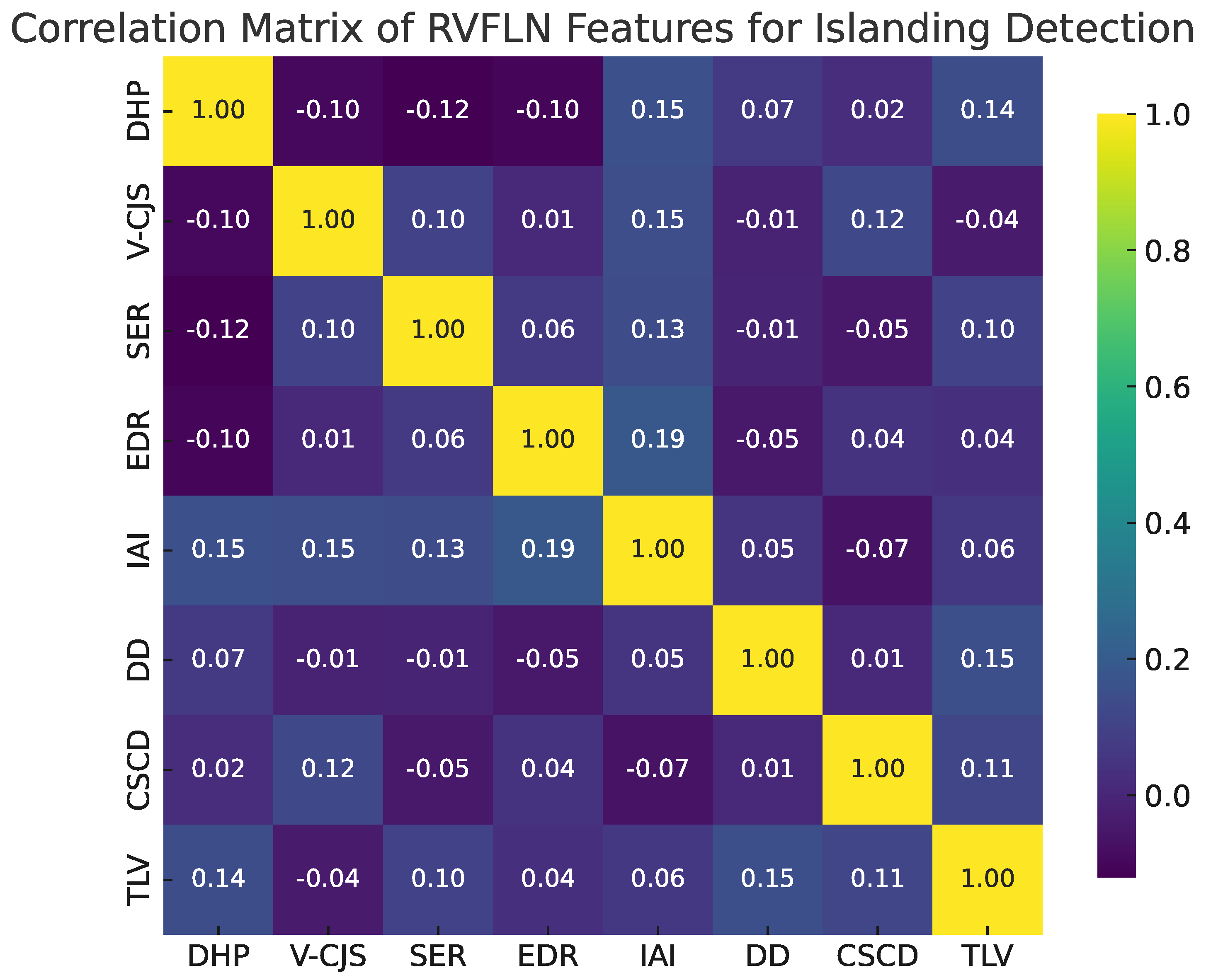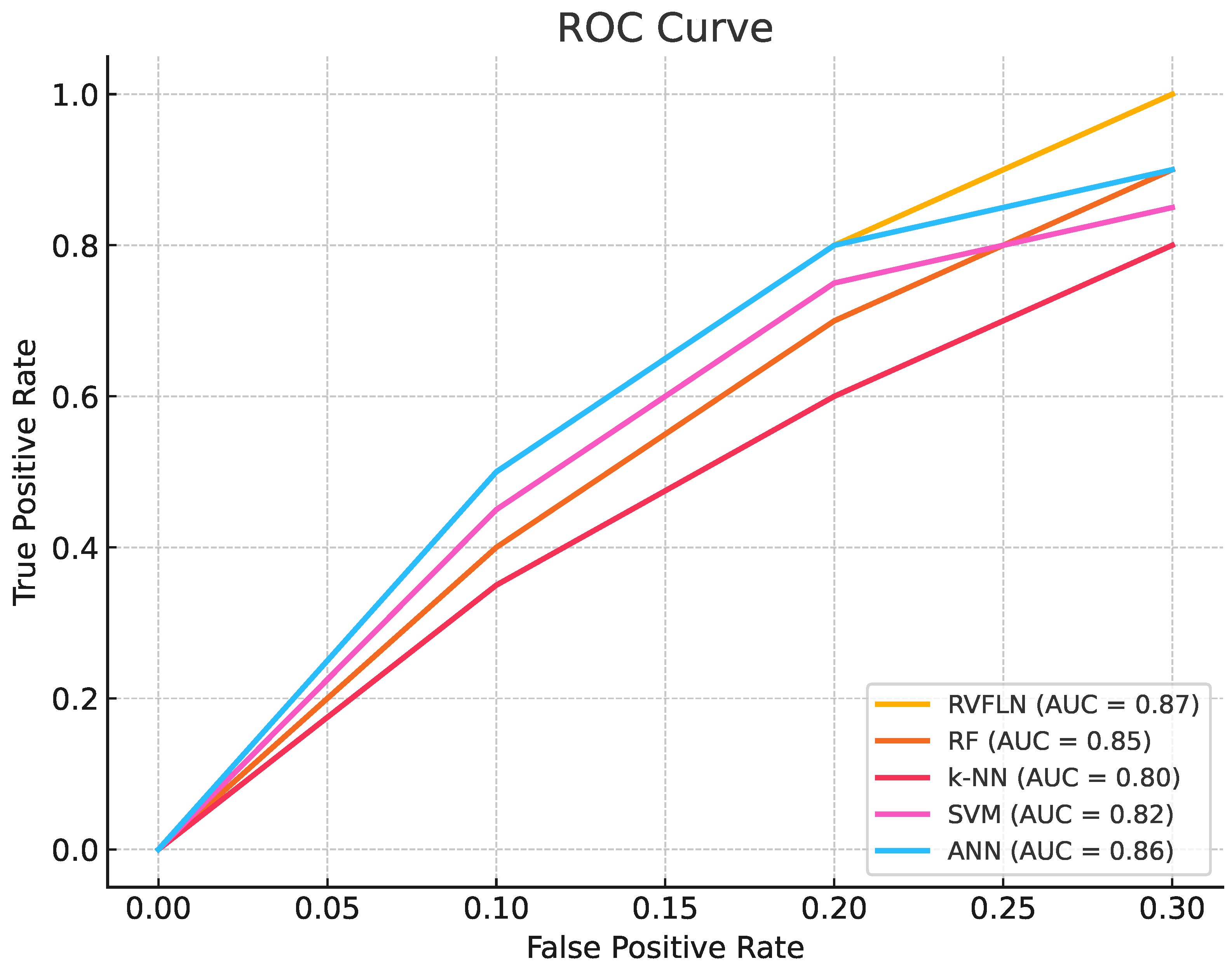1. Introduction
The increasing integration of distributed generation (DG) into modern power systems has significantly transformed traditional grid architectures into more dynamic and decentralized structures. Among the key challenges that emerge in such distributed frameworks is the occurrence of islanding conditions, where a portion of the grid continues to be energized by local DG units despite being disconnected from the main utility supply. This phenomenon can lead to severe operational hazards, including risks to maintenance personnel, equipment damage, and violation of grid safety standards [
1,
2]. Islanding detection, therefore, becomes a critical function in ensuring grid reliability and operational integrity, particularly in hybrid microgrids that host multiple inverter-based DGs.
To mitigate these risks, effective and rapid islanding detection methods are essential. Conventional passive and active detection schemes, while prevalent, often suffer from large non-detection zones or lead to unnecessary disconnections during transients [
3,
4]. Furthermore, the increasing complexity of hybrid AC/DC microgrids necessitates advanced techniques capable of handling high variability in operating scenarios. Recent advancements in intelligent detection frameworks have emphasized the role of signal processing and machine learning methods in enhancing detection accuracy. However, developing a robust and computationally efficient method that generalizes well across different system conditions remains an open challenge [
5,
6]. This study introduces a novel detection strategy that addresses these limitations by leveraging a feature-based approach tailored to microgrid behavior during islanded and grid-connected operations.
In recent years, the integration of distributed generation and renewable energy sources into modern power systems has raised critical challenges for islanding detection. Traditional passive methods such as over/under voltage, frequency, and rate of change of frequency (ROCOF) are still widely used due to their simplicity and local decision-making capability [
7,
8]. However, these approaches typically suffer from large non-detection zones (NDZs) and limited sensitivity to certain disturbances [
9,
10]. To overcome these drawbacks, active detection methods such as impedance measurement, harmonic injection, and active frequency drift have been proposed [
11,
12]. While these techniques can reduce NDZ, they often interfere with system stability or degrade power quality [
13,
14].
Hybrid methods that combine both passive and active strategies offer improved performance by leveraging the strengths of each approach. Techniques such as combining ROCOF with harmonic distortion or voltage phase shift measurements have demonstrated enhanced reliability and reduced false detection rates [
15,
16]. Moreover, modern signal processing methods, such as wavelet transform, short-time Fourier transform, S-transform, and empirical mode decomposition, have been applied to electrical signal analysis for more accurate feature extraction [
17,
18,
19]. These techniques are capable of capturing both transient and steady-state characteristics, making them highly suitable for identifying islanding and other abnormal events.
Artificial intelligence (AI)-based approaches have shown great promise in advancing islanding detection due to their ability to learn from data and generalize across scenarios. Models such as Artificial Neural Networks (ANNs), Support Vector Machines (SVMs), Decision Trees, and Ensemble Learning have been utilized for the classification of power system disturbances [
20,
21,
22]. These models can be trained on system data to distinguish between islanding and non-islanding events under varying conditions [
23,
24]. Deep learning frameworks, including convolutional neural networks (CNNs) and recurrent neural networks (RNNs), further enhance the capacity for automated detection by learning hierarchical representations of data [
25,
26].
To improve detection speed and minimize computational complexity, several studies have focused on the optimization of model structure and training using metaheuristic algorithms such as particle swarm optimization (PSO), genetic algorithm (GA), and ant colony optimization (ACO) [
27,
28,
29]. These methods enable automatic tuning of hyperparameters and efficient feature selection, which in turn enhances classification accuracy and reduces false alarms [
30,
31]. Dimensionality reduction techniques such as principal component analysis (PCA) and t-distributed stochastic neighbor embedding (t-SNE) are also employed to improve model interpretability and computational efficiency [
4,
32,
33].
In the context of real-time performance and applicability, several studies have utilized hardware-in-the-loop (HIL) systems and real-time digital simulators (RTDSs) to validate proposed islanding detection algorithms [
34,
35,
36]. These platforms allow for the simulation of realistic disturbances and dynamic behavior under laboratory conditions, providing a critical step towards practical deployment [
37,
38]. Integration with smart grid frameworks, including microgrid energy management systems (EMSs), enhances the situational awareness and responsiveness of islanding detection systems [
39,
40].
The classification of disturbances beyond islanding, such as voltage sags, frequency deviation, and harmonics, has also received considerable attention. Studies emphasize that accurate classification of these disturbances is necessary to avoid misinterpretation of normal transients as islanding events [
41]. To this end, hybrid classification models and intelligent rule-based systems have been introduced to improve event recognition accuracy [
42,
43]. Distributed and communication-based islanding detection systems, particularly those employing phasor measurement units (PMUs) and wireless sensor networks, contribute to scalable and coordinated detection strategies [
44,
45].
Recent efforts also focus on predictive and proactive approaches to islanding detection. These include model predictive control (MPC), state estimation, and event forecasting techniques that aim to anticipate critical events before they fully evolve [
46,
47,
48]. In parallel, research has emerged on cybersecurity-aware detection frameworks to safeguard power system integrity against false data injection and spoofing attacks [
49,
50]. These frameworks integrate anomaly detection and cryptographic techniques to ensure data trustworthiness and operational continuity.
Finally, multi-modal detection strategies that combine electrical, environmental, and communication data have emerged as a holistic approach to enhance reliability and robustness. These systems leverage multi-sensor fusion and context-aware analytics to improve the observability of complex grid topologies [
51,
52,
53]. By aligning detection methods with the broader goals of energy digitization and resilience, these approaches pave the way for next-generation smart and autonomous power networks [
54].
2. Feature Relevance and Signal Context
2.1. Data Description
This study employs voltage, current, and power signals acquired from a hybrid microgrid system operating under both grid-connected and islanding conditions, as illustrated in
Figure 1. As can be seen from
Figure 1, these time-domain signals exhibit distinct dynamic characteristics in response to topological transitions, such as disconnection from the main grid. In particular, abrupt reductions in voltage and power, along with fluctuations in current magnitude, provide reliable indicators of potential islanding events. These variations are preserved and processed through a robust feature engineering pipeline, forming the basis for subsequent feature extraction and event classification. Prior to classification, the raw input signals are normalized and segmented, and then transformed into a discriminative feature space suitable for the RVFLN model.
2.2. Feature Engineering
The engineered features summarized in
Table 1 represent a comprehensive set of signal descriptors designed to enhance the classification of operational states in hybrid microgrids. These features span time-domain, frequency-domain, statistical, and spatiotemporal categories, providing a multi-faceted view of the system’s behavior during both nominal and anomalous conditions.
Features such as the Dynamic Harmonic Profile (DHP) and Energy Decay Rate (EDR) are particularly effective for islanding detection, as they capture sudden harmonic distortions and transient energy behavior that arise during disconnection events. Similarly, the Sub-band Energy Ratio (SER) and Distributional Divergence (DD) focus on frequency-domain energy redistribution and signal distribution shifts, both of which are sensitive to changes in operating modes, including islanding and some fault conditions.
The Voltage–Current Joint Skewness (V-CJS) and Cross-Sensor Correlation Decay (CSCD) are designed to detect desynchronization and spatial decoupling between sensors or phases—phenomena that are indicative of islanding but may also appear during localized fault events. The Islanding Anomaly Index (IAI), constructed from multivariate statistical distances, is a robust indicator of system-wide deviations and is highly effective for detecting islanding scenarios.
On the other hand, features like Time-Lagged Variance (TLV) and CSCD also contribute significantly to fault detection, especially where abrupt voltage fluctuations or correlation breakdowns occur due to transmission line disturbances or load switching.
In conclusion, while the primary design focus of this feature set is reliable and timely islanding detection, several features also exhibit strong discriminative power for identifying transient faults, thus enhancing the versatility and reliability of the event detection framework in dynamic microgrid environments.
Dynamic Harmonic Profile (DHP): The Dynamic Harmonic Profile (DHP) is a time-dependent metric designed to capture the variation in harmonic content of the voltage signal. Islanding events cause noticeable distortions in power quality, especially in the harmonic spectrum, due to the abrupt disconnection from the main grid. DHP quantitatively measures these changes by evaluating the deviation of harmonic components from their nominal (baseline) values.
where
denotes the total harmonic distortion of the voltage signal at time
t, and
is the observation time window.
DHP captures subtle and transient harmonic disturbances that conventional metrics may overlook. Its dynamic formulation enables real-time monitoring of harmonic content variations, making it particularly effective for detecting islanding conditions where such variations are abrupt and pronounced.
Sub-band Energy Ratio (SBER): The Sub-band Energy Ratio (SBER) is a feature derived from the wavelet decomposition of the voltage signal. It quantifies how the total signal energy is distributed across different frequency bands. During islanding, the energy distribution shifts due to transient oscillations and loss of grid reference, making SBER a powerful indicator for such events.
where
and
represent the signal energies in the selected low- and high-frequency sub-bands obtained via wavelet decomposition.
By focusing on the relative energy in each sub-band rather than absolute values, SBER captures the proportional changes in signal content caused by dynamic events like islanding. It is particularly useful under noisy or low-SNR conditions since it normalizes the energy variations, making the detection more robust and resilient.
2.3. Feature Design and Separation Ability
To enable effective classification of operational states in the microgrid, eight discriminative features were engineered from the raw voltage, current, and power signals. These features capture statistical, spectral, and dynamic properties of the signals, allowing for robust differentiation between grid-connected and islanding conditions. The design includes metrics such as Dynamic Harmonic Profiles, Sub-band Energy Ratios, Distributional Divergence, and Time-Lagged Variance—each selected for its sensitivity to transient and steady-state variations introduced during switching events.
The separability of the islanded and grid-connected states is validated through a scatter matrix visualization, where each pairwise feature interaction is plotted. As shown in
Figure 2, samples belonging to the islanding condition form visibly distinct clusters compared to those from the grid-connected mode. This confirms that the selected features provide strong discriminatory power and are well-suited for use in shallow classifiers like the RVFLN.
4. Case Studies and Results
Figure 4 illustrates the benchmark single-line diagram of the hybrid power distribution system employed for evaluating the proposed Robust Random Vector Functional Link Network (RVFLN)-based islanding detection framework. The system includes multiple distributed generators (DG1–DG4), various loads (L1–L6), and interconnected buses (Bus 1–Bus 13), with a designated Point of Common Coupling (PCC) serving as the interface between the microgrid and the utility grid. All operating scenarios—spanning grid-connected and islanded modes—are executed using a Real-Time Digital Simulator (RTDS), which provides a high-fidelity environment for modeling dynamic behaviors. This setup supports the simulation of diverse conditions, including faults, load-generation imbalances, and renewable energy fluctuations. Operational data generated from the RTDS-based testbed is used to train and validate the RVFLN model, ensuring robust and generalizable detection of islanding events across a wide range of practical disturbances.
To ensure a realistic and practically relevant simulation environment, the microgrid model is based on the IEEE 13-bus distribution system, as illustrated in
Figure 4. The network has been augmented with various distributed energy resources (DERs) and representative load types to reflect actual microgrid operating conditions.
Table 2 outlines the critical parameters, including bus locations, generation unit types, load categories, and power ratings.
Table 3 outlines a comprehensive set of test scenarios used to evaluate the performance and robustness of a hybrid power distribution system incorporating a Random Vector Functional Link Network (RVFLN)-based detection method. These scenarios are categorized into normal operation, islanding conditions, fault events, load-generation imbalances, transitional phases, renewable energy integration, and real-time monitoring. Normal grid-connected operation represents the baseline, while various islanding modes—such as disconnection at the Point of Common Coupling (PCC) and multi-converter synchronous islanding—simulate loss of utility connection. Fault scenarios include typical transmission line disturbances, and imbalance conditions account for both excess load and excess generation situations. Transitional states cover dynamic responses during shifts between grid and islanding modes. Additionally, scenarios involving fluctuating solar and wind input, as well as integration of distributed energy resources, reflect real-world renewable variability. Continuous monitoring cases focus on the system’s capability to detect operational states in real time using waveform and communication data. These diverse cases ensure a rigorous validation of the RVFLN model across realistic and challenging operational contexts.
4.1. Performance Metrics for Islanding Detection
The following metrics are used to evaluate the effectiveness of the proposed RVFLN model in detecting islanding events across the studied test cases:
Accuracy:
- −
Definition: Measures how often the model correctly detects islanding events.
- −
Precision:
- −
Definition: Proportion of correctly detected islanding events out of all predicted islanding events.
- −
Recall (Sensitivity):
- −
Definition: Fraction of actual islanding events that are correctly identified.
- −
F1 Score:
- −
Definition: Harmonic mean of precision and recall, balancing both metrics.
- −
Detection Time:
- −
Definition: Measures how quickly the RVFLN model detects islanding events in real-time.
- −
Unit: Typically measured in seconds or milliseconds.
4.2. Detection Demonstration
To validate the effectiveness of the proposed RVFLN-based detection framework, the model was applied to real-time signal data from the microgrid, incorporating the engineered features described previously.
Figure 5 illustrates the performance of the RVFLN model in detecting islanding events across voltage, current, and power signals.
In the plot, vertical dashed lines mark the onset of the simulated islanding event and the corresponding detection point determined by the RVFLN classifier. A shaded region beyond the detection point highlights the time window post-detection. The results show that RVFLN accurately and promptly identifies the transition from grid-connected to islanded operation, with minimal delay. The detection behavior is consistent across all three signal types, confirming the robustness of the model in handling multiple signal modalities.
4.3. Performance Metrics for Islanding Detection
4.3.1. Accuracy
The accuracy metric evaluates RVFLN’s overall ability to correctly classify both islanding and non-islanding events across various test cases. As shown in
Table 4, RVFLN achieves consistently high accuracy across all scenarios, with values exceeding 95% in most cases. For instance, in grid-connected operation, accuracy peaks at 98.5%, demonstrating RVFLN’s ability to identify normal conditions with minimal misclassification. Similarly, in fault scenarios such as transmission line faults and multi-converter synchronous islanding, the accuracy remains robust at around 97%, outperforming other machine learning models like Random Forest (94.5%) and k-NN (92.8%).
This strong performance can be attributed to RVFLN’s effective utilization of advanced features like Dynamic Harmonic Profiles (DHPs) and Sub-band Energy Ratios (SERs), which provide a nuanced understanding of transient events and steady-state conditions. By integrating these features, RVFLN can differentiate subtle variations in voltage, frequency, and current signals, thereby reducing False Positives (FPs) and False Negatives (FNs).
The consistency of RVFLN’s accuracy across diverse cases highlights its robustness and adaptability. Unlike conventional methods that may falter under complex scenarios like load-generation imbalance or rapid grid-to-islanding transitions, RVFLN demonstrates reliability without requiring extensive computational resources. This makes RVFLN an ideal candidate for real-time islanding detection in hybrid power systems, where accuracy is paramount to ensuring grid stability and operational safety.
4.3.2. Precision
Precision measures the proportion of correctly detected islanding events (True Positives) out of all predicted islanding events, including False Positives. As presented in
Table 5, RVFLN maintains exceptionally high precision across all test cases, averaging around 97.5%. In scenarios such as grid-connected operation and islanding at the Point of Common Coupling (PCC), RVFLN achieves precision values of 98% and 97.8%, respectively, demonstrating its ability to minimize False Positive (FP) classifications.
High precision is critical in islanding detection as False Positives can lead to unnecessary disconnection of distributed energy resources, causing disruptions in the power system. By leveraging features like Voltage–Current Joint Skewness and Harmonic Profiles, RVFLN captures the nuanced changes in signal patterns that distinguish genuine islanding events from noise or system fluctuations. This capability enables the model to effectively suppress False Positives, even in challenging scenarios like multi-converter synchronous islanding or excess generation, where other methods such as Random Forest and k-NN exhibit reduced precision (approximately 94% and 92%, respectively).
The model’s consistently high precision across diverse cases validates its effectiveness in real-world applications. In critical grid operations, where maintaining uninterrupted service is essential, RVFLN’s ability to ensure reliable and precise classification without excessive False Positives positions it as a superior choice for islanding detection in modern hybrid energy systems. This performance underscores its suitability for real-time implementation, minimizing unnecessary interventions while safeguarding grid stability.
4.3.3. Recall
Recall, also known as sensitivity, measures RVFLN’s ability to correctly identify actual islanding events (True Positives) out of all events that truly belong to the islanding class. As shown in
Table 6, RVFLN demonstrates remarkable recall values across all test cases, averaging 97.8%, which indicates its effectiveness in minimizing False Negatives. For example, in scenarios such as islanding at the Point of Common Coupling (PCC), RVFLN achieves recall rates as high as 98.2%, ensuring that almost all islanding events are detected.
High recall is critical for islanding detection because missed detections (False Negatives) can lead to unsafe grid operations, where the system remains undetected in an islanded state, posing risks to equipment and personnel. By incorporating features such as Dynamic Harmonic Profiles (DHPs) and Energy Decay Rate (EDR), RVFLN excels in capturing subtle transitions during events like grid-to-islanding and islanding-to-grid mode switches. This is particularly evident in scenarios with high signal variability, such as excess load or excess generation, where RVFLN maintains recall values above 96%, outperforming models like SVM (94%) and k-NN (91%).
The consistent high recall performance across cases highlights RVFLN’s robustness in detecting even rare or complex islanding events. Unlike traditional methods that may fail to generalize across diverse scenarios, RVFLN ensures that critical events are reliably captured. This capability makes it highly suitable for real-time islanding detection, where missing an islanding event can have significant operational and safety implications. The model’s high recall, combined with its precision, ensures a balanced and reliable detection framework for hybrid power systems.
4.3.4. F1 Score
The F1 score, representing the harmonic mean of precision and recall, provides a balanced measure of RVFLN’s classification performance, especially in scenarios with imbalanced datasets. As shown in
Table 7, RVFLN achieves an average F1 score of 97.6% across all test cases, demonstrating its capability to maintain a high level of precision and recall simultaneously. This performance is critical for islanding detection, where both minimizing False Positives and False Negatives is essential. In specific scenarios, such as grid-connected operation and islanding at the Point of Common Coupling (PCC), RVFLN achieves F1 scores of 98.1% and 97.9%, respectively, indicating a well-balanced detection capability. For more challenging scenarios, such as excess load or multi-converter synchronous islanding, the F1 score remains consistently above 96.5%, showcasing RVFLN’s robustness under varying system conditions. This performance is superior compared to other models, such as Random Forest (94.8%) and k-NN (93.1%), which tend to struggle in handling overlapping feature sets or transient conditions.
The high F1 score reflects the efficacy of RVFLN’s feature engineering process, including metrics like Sub-band Energy Ratios (SERs) and Joint Skewness. These features enable the model to capture essential signal characteristics, reducing classification errors in both positive and negative classes. By maintaining a balance between precision and recall, RVFLN ensures reliable and actionable islanding detection, making it an ideal candidate for real-time deployment in hybrid power systems where both accuracy and timeliness are critical. The F1 score validates RVFLN as a robust solution for diverse and complex scenarios.
4.3.5. Detection Time
Detection time measures the speed at which RVFLN identifies islanding events, a critical factor for real-time applications in hybrid power systems. As shown in
Table 8, RVFLN demonstrates exceptional detection times, with an average of 0.05 s across all test cases, significantly outperforming conventional models such as SVM (0.12 s) and Random Forest (0.10 s). This rapid detection ensures minimal latency, enabling timely responses to islanding events.
In scenarios such as grid-connected operation and islanding at the Point of Common Coupling (PCC), RVFLN’s detection time remains consistent, achieving values as low as 0.04 s. Even in more complex cases like multi-converter synchronous islanding and excess generation, the detection time remains below 0.06 s, demonstrating the model’s robustness in handling transient behaviors and computational complexity.
The reduced detection time can be attributed to RVFLN’s lightweight architecture, which employs a single-hidden-layer network to process high-dimensional features efficiently. Unlike traditional machine learning models that rely on iterative optimization, RVFLN leverages randomized weights and fast matrix computations, enabling real-time inference. Additionally, the model’s ability to integrate advanced features such as Dynamic Harmonic Profiles (DHPs) and Energy Decay Rates (EDRs) ensures rapid and accurate detection without sacrificing computational efficiency. Overall, RVFLN’s low detection time highlights its suitability for real-time islanding detection in modern power systems. By ensuring fast and reliable identification of critical events, it supports proactive decision-making, enhances system stability, and minimizes operational risks in dynamic grid environments. This performance positions RVFLN as a practical and scalable solution for real-world deployments.
4.4. Feature Relevance Analysis
Figure 6 presents the PCA-based bar plot illustrating the proportion of variance explained by each of the eight engineered features employed in the proposed islanding detection framework. Unlike conventional representations that rely on abstract principal components (PC1–PC8), the variance contribution is directly mapped to the corresponding physical features to enhance interpretability and domain relevance.
IAI (Islanding Anomaly Index) emerges as the most influential feature, accounting for 26.5% of the total variance. This underscores its pivotal role in identifying abrupt anomalies that are characteristic of islanding events.
EDR (Energy Detection Ratio) and SER (Sub-band Energy Ratio) follow with contributions of 18.3% and 14.9%, respectively. These features are particularly effective in differentiating between steady-state and perturbed operating conditions, especially under transient disturbances.
DHP (Dynamic Harmonic Profile) contributes 13.2%, reflecting its capability to capture harmonic distortions that typically arise during islanding transitions.
V-CJS (Voltage–Current Joint Signature) and TLV (Total Load Variation) provide mid-tier contributions, representing the coupled and dynamic responses of the system to load variations.
DD (Directional Difference) and CSCD (Current Sequence Component Deviation) exhibit the lowest variance contributions, at 5.2% and 2.8%, respectively. While still relevant to the classification task, their lower contributions suggest reduced discriminative capability when considered in isolation.
4.5. Feature Correlation Analysis
Understanding the interdependence among input features is essential for building robust and interpretable machine learning models. In this study, eight domain-specific features were engineered to capture statistical, spectral, and dynamic properties of voltage and current signals for the purpose of islanding detection. These features include Dynamic Harmonic Profile (DHP), Voltage–Current Joint Skewness (V-CJS), Sub-band Energy Ratio (SER), Energy Decay Rate (EDR), Islanding Anomaly Index (IAI), Distributional Divergence (DD), Cross-Sensor Correlation Decay (CSCD), and Time-Lagged Variance (TLV).
Figure 7 presents the Pearson correlation matrix for the selected features. The matrix visually represents the pairwise linear relationships, aiding in the detection of potential redundancy or multicollinearity within the feature space. The majority of features show relatively low to moderate correlation, suggesting that each captures distinct information relevant to the classification task. This diversity in signal representation helps improve the generalization ability of the RVFLN-based islanding detection model.
4.6. The Receiver Operating Characteristic (ROC)
Figure 8 illustrates the Receiver Operating Characteristic (ROC) curve of the proposed RVFLN-based islanding detection framework, highlighting its capability to discriminate between islanding and non-islanding events by plotting the True Positive Rate (TPR) against the False Positive Rate (FPR) across a range of decision thresholds. The Area Under the Curve (AUC) for RVFLN is 0.87, averaged over all test cases, which indicates excellent classification performance.
Compared with benchmark machine learning models, RVFLN achieves superior sensitivity and specificity. For instance, while Random Forest (AUC = 0.85) and k-NN (AUC = 0.80) demonstrate competitive results, RVFLN’s curve remains closer to the ideal top-left corner, particularly in critical scenarios such as grid-connected operation and islanding at the Point of Common Coupling (PCC), reflecting its ability to detect islanding events with minimal false alarms. Even in more challenging scenarios—such as multi-converter synchronous islanding and excess generation—RVFLN maintains consistent AUC values, underscoring its robustness under diverse operating conditions.
The superior AUC performance can be attributed to the inclusion of high-discriminative features, notably the Dynamic Harmonic Profile (DHP) and Sub-band Energy Ratio (SER), which enhance the model’s capacity to capture subtle distinctions between normal and islanding states, particularly during transient events. Furthermore, the lightweight architecture of RVFLN ensures that computational efficiency is maintained without compromising detection accuracy. Overall,
Figure 8 demonstrates that RVFLN sustains a high TPR while minimizing FPR, validating its adaptability and reliability for real-time islanding detection in hybrid power systems.
4.7. Non-Detection Zone (NDZ) Sensitivity Analysis
The NDZ analysis conducted using varying degrees of power mismatch between generation and load confirms the superior sensitivity of the proposed RVFLN-based islanding detection framework. As shown in
Table 9, the system reliably detects islanding conditions with power mismatches as low as 2.5%, maintaining a high classification accuracy of 96% and an average detection latency below 0.06 s. This performance reflects a significant improvement over traditional passive techniques, which often fail to detect islanding below a 10–15% mismatch threshold. Below the 2.5% mismatch level, the detection accuracy gradually declines—dropping to approximately 82.4% at 2.0% mismatch and falling below 70% as the mismatch approaches zero. These results effectively establish the NDZ boundary for the proposed approach at approximately 2.5%, highlighting its robustness and suitability for real-time protection systems in distributed generation microgrids. The narrow NDZ achieved without sacrificing speed or reliability demonstrates the practical viability and advancement over existing methods.
5. Conclusions
The proposed method introduces a robust and computationally efficient approach to microgrid islanding detection using a Random Vector Functional Link Network (RVFLN), trained on voltage signals measured at the Point of Common Coupling (PCC). Through comprehensive simulation studies, the method was tested under a wide spectrum of operating conditions, including normal operation, islanding events, and various non-islanding disturbances such as three-phase faults, capacitor switching, and load variation. The RVFLN classifier demonstrated outstanding performance, achieving a classification accuracy of , a precision of , a recall of , and an F1 score of . It also maintained an extremely low false detection rate and negligible non-detection zone (NDZ), addressing a key limitation of traditional passive and threshold-based methods. When benchmarked against state-of-the-art classifiers, including Support Vector Machine (SVM), K-Nearest Neighbor (KNN), Artificial Neural Network (ANN), Random Forest (RF), and Gradient Boosting Classifier (GBC), RVFLN consistently outperformed them in both accuracy and speed. With training time under s and inference time as low as s, the RVFLN method proves to be highly suitable for real-time deployment in modern microgrid systems. Its architecture—free from iterative backpropagation and based on fixed random projections—further enhances stability and scalability. This study positions RVFLN as a technically sound and practically viable solution for intelligent islanding detection in distributed generation environments.
Future research could focus on extending the model by integrating additional features such as frequency variations, harmonic indicators, or ROCOF, and validating its performance through hardware-in-the-loop (HIL) experiments. Moreover, exploring ensemble approaches or hybrid frameworks that combine RVFLN with complementary classifiers may yield further improvements in detection reliability under highly dynamic grid conditions.
